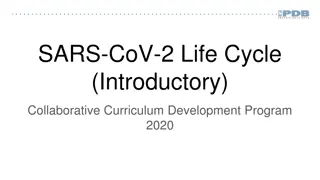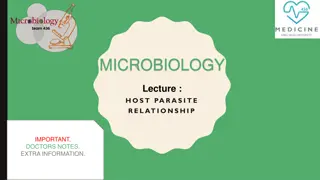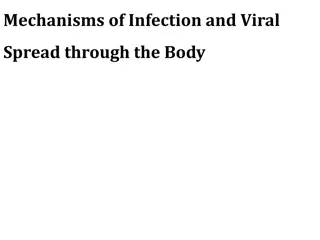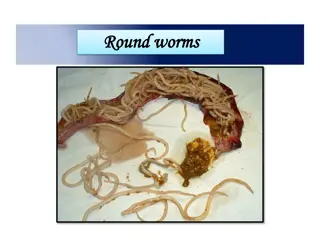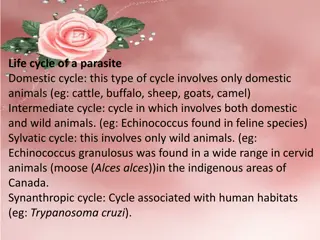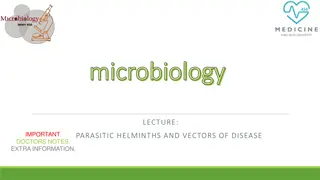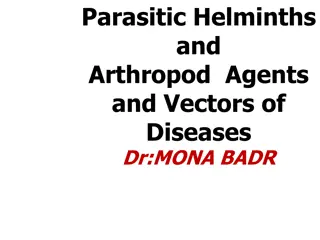Life Cycle of Ascaris lumbricoides in Human Host
Ascaris lumbricoides, commonly known as roundworm, is a human parasite found in the intestine. The life cycle involves copulation, egg development, and infection of a new host through ingestion of eggs. It does not require an intermediate host. The larval stages undergo migration within the body. The development process includes spiral cleavage, formation of larva, and an infective stage called rhabditoid. The eggs of infective stages can survive in soil for years.
Download Presentation

Please find below an Image/Link to download the presentation.
The content on the website is provided AS IS for your information and personal use only. It may not be sold, licensed, or shared on other websites without obtaining consent from the author.If you encounter any issues during the download, it is possible that the publisher has removed the file from their server.
You are allowed to download the files provided on this website for personal or commercial use, subject to the condition that they are used lawfully. All files are the property of their respective owners.
The content on the website is provided AS IS for your information and personal use only. It may not be sold, licensed, or shared on other websites without obtaining consent from the author.
E N D
Presentation Transcript
ASCARIS LUMBRICOIDES ASCARIS LUMBRICOIDES PHYLUM:NEMATYHELMINTHES CLASS:NEMATODA ORDER:ASCAROIDEA
INTRODUCTION INTRODUCTION Ascaris is commonly called round worm because of its shape. Its species are found in intestinal parasites in many vertebrates like man,pig,cattle etc. Ascaris lumbricoides is a human parasite and an endoparasite seen in intestine. It is most common parasite seen in all over the world. The No.of round worms in a single host is unlimited 1000-5000 can be seen in one individual.
LIFE HISTORY LIFE HISTORY Male and female worms live in intestine. Hence copulation takes place there only. Male rotates its body at right angler to female so that it s cloacal aperture apposes vulva of female. Pemial sets of male opens vulva and sperms are transferred to vagina. Second maturation division occurs after fertilization.
(a)DEVELOPMENT: (a)DEVELOPMENT: The fertilized egg passes the uterus and the uterus wall secretes outer thick yellow albumin layer called outer shell. These eggs are mamiliated eggs which are elliptical in shape. Under favourable conditions of temperature and moisture the eggs undergo cleavage which is spiral and determine. The dividing of micromere and arranging in layer one above other spirally is called spiral cleavage. The cleavage gives rise to blastula having cavity called blastocoel.Later gastrula is formed. In 10-14 days juvenite is formed which has alimentary canal,nerve ring. The first stage of larva is RHABDITIFORM LARVA. The infective stage is called RHABDITOID. Which is formed by the moulting with in the egg shell. The eggs of infective stages can remain in soil for six years.
(b) INFECTION OF NEW HOST: (b) INFECTION OF NEW HOST: There is no intermediate host in life history of ascaris. It reaches another man when he ingests eggs directly through contaminated food and water. These eggs reach the small intestine by action of digestive enzymes the egg shell is dissolved and rhabditoids are released. They are 0.2 to 0.3mm long and 13-15 in diameter. They have all adult structures except reproductive organs.
(c) MIGRATION: (c) MIGRATION: The juvenile stages released in intestine don't undergo any development but migrate to other parts in 8-10 days and reach intestine. The juvenile stages bore through intestinal wall and reach liver through portal circulation. They travel to heart through post caul vein and carried to lungs by pulmonary artery. Larvae remain 3-4 days to increase in size. In alveoli it moults for second time again in six days the third stage larva is released. After four days it moults for 3rd time end fourth stage larva is released. The larva undergoes two moults in lungs.
(d)SECOND MIGRATION: (d)SECOND MIGRATION: Fourth stage larva make their own way through bronchioles,bronchus to trachea. During extra intestinal migration, juvenile stages grow & increase in size. [2-3mm] In intestine they moult for fourth time and become adults. They reach sexual maturity in 60-75 days. Some Larvae migrate but reach other organs like brain,spinal cord Hence further development does not take place but calcareous cyst if formed.
PATHOGENECITY OF ASCARIS PATHOGENECITY OF ASCARIS INTRODUCTION: INTRODUCTION: Ascaris is a monogenetic internal nematode endo parasite living in human intestine. Infection with ascaris causes no symptoms. Infection by A.lumbricoides in man Causes ascariasis in two phases. PHASE 1 : migrating larvae cause pathological lesions. They depend upon sensitivity & nutritional status host,No.of migrating larvae. During migration through lungs it causes pneumonia with low grade fever,cough, allergic symptoms. PHASE 2 : adult worms may produce no symptoms but block intestine and cause abdomen pain in children. They also produce trauma and block bile ducts & small intestine, affect nutritional status leading to malnutrition & growth retardation. The metabolites of living or dead are toxic and immunogenic.They produce various allergic toxins leading to fever, irritation, conjunctivitis.
TYPES OF ASCARIASIS TYPES OF ASCARIASIS Ascariasis is of two types 1.INTESTINAL ASCARIASIS : It is identified by nausea, vomiting, abdominal pain & distention, weight loss, diarrhoea. In children leads to appendicitis, perforation of bile duct, hepatomegaly. 2.PULMONARY ASCARIASIS : This is diagnosed by transient eosinophilic pneumonitis, elevated IgE,bronchospasm,dyspnea, wheezing,fever,non productive cough & chest pain. 3.TREATMENT AND PROPHYLAXIS : Medicines like mebendazole , Albendazole , Pytantel pamoate are commonly used.



